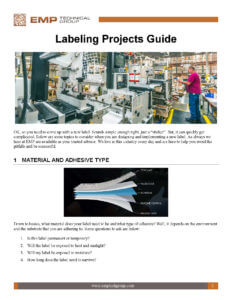So you need to come up with a new label. Sounds simple enough, right? But, it can quickly get complicated. Below are some topics to consider when you are designing and implementing a new label.
Material and Adhesive Type
Down to basics. What material does your label need to be, and what type of adhesive should you use? Well, it depends on the substrate you are adhering to and the environment. Some questions to ask are below:
- Is this label permanent or temporary?
- Will the label be exposed to heat and sunlight?
- Will my label be exposed to moisture?
- How long does the label need to survive?
- Does it need to be a label or can it be a tag?
- Where am I going to put the label on my product?
- Does my label need to be destructible or tamper evident?
- Is my label going to cover up another label?
Information on Your Label
So, you have figured out the label material and adhesive type for your labeling project. Now you need to think about the information that needs to go on your label. Some things to consider are:
- Is my label color or is it black and white?
- If color, how many colors is my label?
- Is the information all static or will there be variable print?
- If there is variable print, does it need to be printed at time of application or can it be pre-printed?
- Is the variable print one color and can that color be black?
- Are there any industry standards that apply to your label, UL, GS1, AIAG, FDA, USDA, etc.?
- Will there be bar codes on your label and if so, what type?
- Does my label require any type of RFID?
Printing Methods
There are a lot of methods for printing labels and tags. Flexographic, offset, direct thermal, thermal transfer, inkjet, laser, screen printing, etc. Your label might have a mix of printing technologies before it is finished. Our label plant that produces labels uses flexographic, inkjet, and thermal transfer in our processes. You could receive flexo printed labels from us and then use some form of thermal, laser, or inkjet printing to complete the label in your operations. Here are some things to consider as you move through this step in the process:
- If your label is a color, decorative label and the volume is high enough, can flexographic printing be used?
- Can the plate and die costs of flexographic be cost justified?
- Is your label a color, decorative label and the volume is low enough for digital printing to make sense?
- If your label is black and white with variable information, can it be printed at the time of application?
- What is the life expectancy of your label, if it is short, can you use direct thermal labels?
- Does your label have a color logo and the rest of the print is variable or black? If so, can the logo be printed on press and the variable data be printed with a direct thermal or thermal transfer label printer?
- Do you have variable data that needs to be printed in color, if so does an ink jet printer make sense?
Label Finishing
The most commonly overlooked aspect of a labeling project is the finishing. The heavy lifting is picking the material, adhesive, and print method, but the way your labels come to you is just as important. Below are some questions to ask when determining how to finish your labels:
- Are your labels going to be supplied on sheets, fan folded, or on rolls?
- If your labels are coming on rolls, what is the core size and OD (outer diameter) required?
- If your labels are coming fan folded, what is the number of labels up per layer and per stack?
- Do you need perforations between your labels?
- Are you using automated labeling equipment? If so, what is the max OD that the roll can be?
- Are you using mobile printers? If so, how many labels will you be able to get onto a roll?
- Are there notches or holes die cut into your labels? If so, can the waste be left in place?
- Does your label need a varnish or laminate to protect the print? If so, are you going to print variable data on the label after it is varnished or laminated?
Label Application
You have your label all designed and ready for production. Now, how are you going to get the label to your operators and on your product? When it comes time to apply the label, here are some things to consider for your labeling project:
- Does someone need to hand apply my label or can it be machine applied?
- If my label is being hand applied, will automated label dispensers help my operation?
- If there is variable data to be printed on my label, can it be printed line side at the time of application?
- Do I have the conveyance and automation required to machine apply my labels?
- If I am printing variable data at the time of application, can I peel and present the label to my operator?
- What am I going to do with the liner waste from the labels?
- Can my label be cleanly hand applied without wrinkles or bubbles?
- Do I need some sort of inspection or verification of the label application?
- Do I need some sort of barcode or print verification?
These questions are just a start to ensuring a successful labeling project. There is one thing for sure; the EMP Tech Group is here to help you, as we have already helped hundreds of our customers successfully navigate the sometimes murky waters of labeling. Contact us today, and we will come to your site to help you answer these questions.
